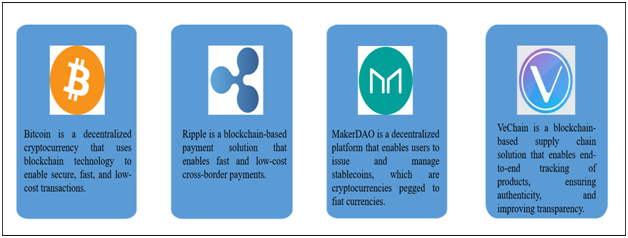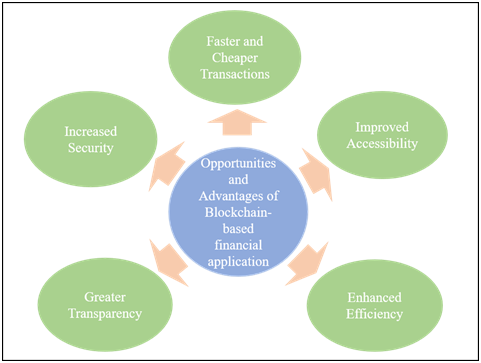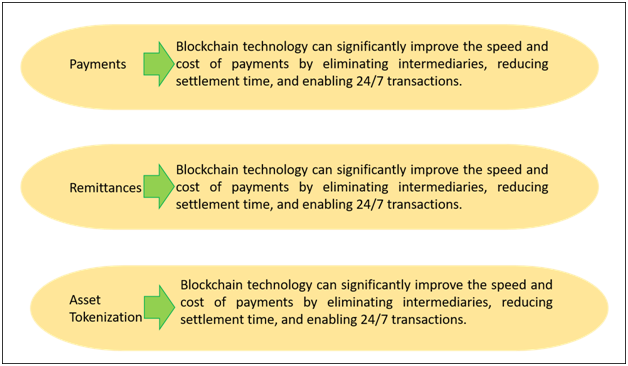Exploring the Potential Impact of Selected Blockchain-Based Financial Applications on the Financial Industry: Opportunities and Challenges
- Hlaing Htake Khaung Tin
- 87-94
- Dec 12, 2023
- Information Technology
Exploring the Potential Impact of Selected Blockchain-Based Financial Applications on the Financial Industry: Opportunities and Challenges
Hlaing Htake Khaung Tin
Faculty of Information Science, University of Information Technology, Myanmar
DOI: https://doi.org/10.51584/IJRIAS.2023.81108
Received: 01 November 2023; Revised: 09 November 2023; Accepted: 15 November 2023; Published: 11 December 2023
ABSTRACT
This research paper explores the landscape of block chain-based financial applications within the financial industry. Block chain technology has emerged as a transformative force, offering a range of opportunities and challenges for financial institutions and companies. This paper highlights the potential benefits of block chain, including enhanced efficiency, reduced costs, and increased security and transparency. However, it also discusses the regulatory, legal, technical, and operational challenges accompanying block chain adoption in finance. Through successful case studies such as Bit coin, Ripple, Marker DAO, and Vechain, the paper illustrates the tangible impact of block chain-based financial solutions. This research emphasizes the need for collaboration, innovation, and problem-solving to address the hurdles associated with block chain integration. In conclusion, the research underscores the transformative potential of block chain-based financial applications and the imperative for financial entities to adapt and embrace this evolving technological landscape.
Keywords: Block chain, Block chain-based Financial Applications, Challenges, Opportunities, Bitcoin, Ripple, Marker DAO, Vechain.
INTRODUCTION
Blockchain technology is a distributed ledger system that allows for secure, transparent and immutable record-keeping. It has gained increasing attention from various industries due to its potential to transform traditional systems by enabling trust, security, and efficiency. In particular, the financial industry is one of the most promising sectors that can benefit from blockchain technology. The decentralized nature of blockchain technology can significantly reduce transaction costs, improve efficiency and transparency, and increase security.
The purpose of this research paper is to explore the opportunities and challenges of blockchain-based financial applications for the financial industry. The paper will provide an overview of blockchain technology and its relevance to the financial industry. Additionally, this paper aims to investigate the following research questions:
- What are the benefits of using blockchain technology in the financial industry?
- What are the challenges and potential drawbacks associated with blockchain adoption in the financial industry?
- What are some successful examples of blockchain-based financial applications?
- What are the future prospects of blockchain-based financial applications in the financial industry?
The scope of this research paper is limited to the exploration of blockchain-based financial applications and their potential impact on the financial industry. This paper does not intend to provide a comprehensive analysis of blockchain technology or its technical aspects. Rather, it aims to provide a comprehensive understanding of the opportunities and challenges associated with the adoption of blockchain technology in the financial industry.
RELATED WORK
A systematic review of the literature on blockchain technology in finance and identified four main research themes: blockchain technology and financial innovation, blockchain technology and financial risk management, blockchain technology and financial regulation, and blockchain technology and financial inclusion. They highlighted the potential benefits of blockchain technology for financial innovation, such as increased efficiency, reduced costs, and improved transparency, but also highlighted the challenges related to regulation, security, and interoperability [1].
A review of the literature on blockchain technology identified several use cases in the financial industry, including payments and remittances, identity management, trade finance, and asset tokenization. The research highlighted the potential benefits of blockchain technology for financial inclusion and reducing transaction costs, but also noted the challenges related to scalability, security, and regulation [2].
The potential of blockchain technology for financial services highlighted the importance of understanding the underlying technology and its implications for various financial services. The research also identified the challenges related to regulatory frameworks, interoperability, and standardization [3].
Research on the economic and regulatory implications of blockchain technology concluded that it could significantly reduce transaction costs and improve transparency in financial services, but also highlighted the challenges related to regulatory compliance and cyber security [4].
The use cases of blockchain technology in the banking industry, include peer-to-peer payments, remittances, and asset management. The research highlighted the potential benefits of blockchain technology for improving the efficiency, security, and transparency of banking transactions, but also noted the challenges related to scalability, interoperability, and adoption [5].
The concept of blockchain technology and its potential application for digital currencies. The research proposed the first decentralized digital currency, Bitcoin, which relies on blockchain technology for secure and transparent transactions. While Bitcoin has faced several challenges related to scalability and regulatory compliance, it has also inspired the development of numerous other blockchain-based digital currencies and financial applications [6].
The efficacy of each business model in facilitating decision-making will be contingent on the unique organizational environment and the specific decision-making situation at hand. Utilizing a blend of various models may be essential to offer a holistic approach to both cost management and decision-making [7].
BLOCKCHAIN-BASED FINANCIAL APPLICATIONS
Blockchain technology offers various financial applications that can benefit the financial industry. Some of the blockchain-based financial applications are shown in table 1.
Table 1. Blockchain-based financial applications
| Payments and Remittances | Blockchain technology can facilitate secure, fast, and low-cost cross-border payments and remittances without the need for intermediaries such as banks. Blockchain-based payment solutions like Ripple, Stellar, and Bitcoin are already being used for international transactions. |
| Asset Tokenization | Asset tokenization is the process of representing physical assets such as real estate, art, and stocks as digital tokens on a blockchain. This enables fractional ownership, liquidity, and faster and cheaper trading of assets. |
| Identity Verification | Blockchain-based identity verification systems can provide secure and efficient ways to verify identity without relying on centralized authorities. These systems can help to reduce fraud, increase privacy, and enable faster onboarding of customers. |
| Supply Chain Management | Blockchain-based supply chain solutions can enable end-to-end tracking of products, reducing counterfeiting, improving transparency, and streamlining logistics. |
The following table 2 shows the potential benefits of blockchain technology for the financial industry are numerous, and some of them include.
Table 2. The potential benefits
| Increased Efficiency | Blockchain technology can automate processes, reduce the need for intermediaries, and eliminate manual errors, thereby increasing efficiency and reducing costs. |
| Enhanced Security | Blockchain technology’s decentralized nature and immutability can provide enhanced security against cyber threats and fraud. |
| Increased Transparency | Blockchain technology can provide transparency by enabling all participants to view and verify transactions, reducing the potential for fraud. |
| Improved Accessibility | Blockchain technology can improve accessibility by providing financial services to individuals who are currently unbanked or underbanked. |
Crypto currency is a type of digital or virtual currency that uses cryptography for security. Unlike traditional currencies issued by governments and central banks (such as the US dollar or the euro), crypto currencies operate on decentralized computer networks, typically based on blockchain technology. Some successful examples of blockchain-based financial applications include: Bitcoin, Ripple(XRP), Maker DAO(MKR), and Vechain.
Bitcoin is a digital currency that operates on a decentralized blockchain network. It allows people to send and receive digital money securely without the need for a central authority like a bank. Maker DAO (MKR) is a crypto currency tied to a platform called Maker DAO, which uses smart contracts to create a stable coin called DAI. DAI is designed to maintain a stable value, making it useful for various financial transactions. VeChain is a blockchain platform that focuses on supply chain management and verification. It allows businesses to track and verify products throughout their supply chain, enhancing transparency and trust. Ripple (XRP) is a digital currency and payment protocol that aims to streamline cross-border transactions. It enables fast and low-cost international money transfers for banks and financial institutions.
These crypto currencies present the following figure 1 leverage blockchain technology to offer unique features and solutions in the world of digital finance.
Figure 1.Blockchain-based cryptocurrencies
Blockchain technology has numerous potential applications in the financial industry, and some of the most promising applications include payments and remittances, asset tokenization, identity verification, and supply chain management. The benefits of blockchain technology for the financial industry include increased efficiency, enhanced security, increased transparency, and improved accessibility. There are also several successful blockchain-based financial applications such as Bitcoin, Ripple, Maker DAO, and VeChain that have already demonstrated the potential of blockchain technology in finance.
OPPORTUNITIES FOR THE FINANCIAL INDUSTRY
Blockchain technology offers significant opportunities for the financial industry. The opportunities and advantages of blockchain-based financial applications for the financial industry are shown in the following figure 2.
Figure 2. Opportunities and Advantages of Blockchain-based financial applications
- Faster and Cheaper Transactions: Blockchain-based financial applications can facilitate faster and cheaper transactions without the need for intermediaries, reducing costs and increasing efficiency.
- Increased Security: Blockchain technology’s decentralized nature and immutability can provide enhanced security against cyber threats and fraud.
- Greater Transparency: Blockchain technology can provide greater transparency by enabling all participants to view and verify transactions, reducing the potential for fraud.
- Enhanced Efficiency: Blockchain technology can automate processes, reduce the need for intermediaries, and eliminate manual errors, thereby increasing efficiency and reducing costs.
- Improved Accessibility: Blockchain technology can improve accessibility by providing financial services to individuals who are currently unbanked or underbanked.
The potential impact of blockchain technology on various financial services such as payments, remittances, and asset tokenization is shown in the following figure 3.
Figure 3.Blockchain technology on various financial services
Blockchain technology can improve efficiency, reduce costs, and increase transparency and security in the financial industry. Blockchain-based financial applications have the potential to transform traditional financial systems by enabling trust, security, and efficiency. Therefore, the financial industry should explore and adopt blockchain technology to leverage its benefits and opportunities.
CHALLENGES FOR THE FINANCIAL INDUSTRY
The above section has highlighted the potential benefits and challenges of blockchain technology for the banking industry, with a particular focus on reducing transaction costs, improving transparency, and enhancing security. However, more research is needed to fully understand the implications of blockchain technology for the banking industry and address the challenges related to regulatory compliance, scalability, and adoption.
While blockchain-based financial applications offer significant opportunities, they also come with several challenges and potential drawbacks. Some of the challenges associated with blockchain-based financial applications are shown in the following table 3.
Table 3.Challenges for the financial industry
| No. | Challenges | Description |
| 1 | Regulatory and Legal Challenges | Blockchain technology poses regulatory and legal challenges, including unclear legal frameworks, jurisdictional issues, and compliance requirements. |
| 2 | Technical and Operational Challenges | Blockchain technology requires significant technical expertise, operational infrastructure, and standardization to function effectively. Additionally, blockchain adoption involves significant upfront investment and requires coordination among multiple stakeholders. |
| 3 | Scalability and Interoperability | Blockchain technology faces scalability and interoperability challenges, especially when dealing with large-scale transactions or integrating with existing financial systems |
| 4 | Security and Privacy Concerns | Blockchain technology poses unique security and privacy challenges, such as smart contract vulnerabilities, potential 51% attacks, and the risk of private information being exposed. |
To overcome these challenges, the financial industry needs to address regulatory and legal concerns, establish clear standards, and invest in technical infrastructure and security measures. Additionally, the industry must educate stakeholders, promote collaboration, and incentivize innovation to facilitate the adoption of blockchain technology. The challenges associated with blockchain-based financial applications are significant, and the financial industry must address them to leverage the potential benefits of blockchain technology fully.
FINDINGS AND DISCUSSIONS
In order to gain a comprehensive understanding of the opportunities and challenges presented by blockchain-based financial applications in the financial industry, we will now investigate into the following key research questions:
1. Benefits of using blockchain technology in the financial industry
This section will highlight the advantages that blockchain technology brings to the financial sector, including increased security, transparency, and efficiency.
(a) Payments and Remittances
Blockchain enables near-instantaneous cross-border transactions, reducing settlement times from days to minutes. This is particularly beneficial for international payments and remittances, which often involve multiple intermediaries and high fees. Smart contracts can automate payment processes, ensuring that funds are released only when specified conditions are met, enhancing security and trust. Transparency and immutability of transactions on the blockchain provide a high level of auditability, reducing fraud and dispute resolution costs.
(b) Asset Tokenization
Tokenizing assets like real estate, art, and commodities makes them more accessible to a wider range of investors, enabling fractional ownership and increasing liquidity in traditionally illiquid markets. Through programmable tokens, smart contracts can automatically enforce ownership rules, distribute profits, and facilitate trading, streamlining the entire asset lifecycle.
2. Challenges and potential drawbacks associated with blockchain adoption in the financial industry
We will examine the obstacles that may hinder the widespread adoption of blockchain in finance, as well as potential drawbacks such as scalability issues and regulatory concerns.
(a) Payments and Remittances
Scalability remains a concern, as blockchain networks can experience congestion during periods of high transaction volume, potentially slowing down payment processing times. Regulatory frameworks vary by jurisdiction, and compliance with anti-money laundering (AML) and know-your-customer (KYC) regulations is crucial for widespread adoption.
(b) Asset Tokenization
Legal and regulatory compliance is a critical issue, as different jurisdictions have varying laws regarding the issuance and trading of tokenized assets. Overcoming these hurdles is essential for widespread adoption. Standardization of token formats and interoperability between different blockchain platforms is necessary for seamless trading and transferability.
3. Successful examples of blockchain-based financial applications
This segment will showcase real-world instances where blockchain technology has been successfully implemented in financial applications, demonstrating its potential to revolutionize various aspects of the industry.
(a) Payments and Remittances
Ripple’s XRP and its Ripple Net platform have gained traction in facilitating fast, low-cost cross-border payments for financial institutions and remittance services.
(b) Asset Tokenization
Projects like Real T and Polymath have successfully tokenized real estate assets, democratizing access to property ownership and providing investors with new opportunities for diversification.
4. Future prospects of blockchain-based financial applications in the financial industry
We will explore the long-term outlook for blockchain in finance, considering factors like evolving technology, regulatory frameworks, and emerging trends.
(a) Payments and Remittances
Continued innovation in consensus mechanisms (e.g., sharding, layer 2 solutions) and the emergence of central bank digital currencies (CBDCs) could significantly improve the scalability and efficiency of blockchain-based payments.
(b) Asset Tokenization
As regulatory clarity increases, we can expect to see a broader range of assets being tokenized, including traditionally illiquid assets like fine art, intellectual property, and rare collectibles.
FUTURE OUTLOOK OF BLOCKCHAIN-BASED FINANCIAL APPLICATIONS
Blockchain-based financial applications have the potential to transform the financial industry by enabling faster, cheaper, and more secure transactions. As the technology evolves, we can expect to see several emerging trends and developments in the field, such as:
- With the increasing awareness of blockchain technology and its potential benefits, we can expect to see more financial institutions and companies adopting blockchain-based financial applications in the future.
- Interoperability remains a significant challenge for blockchain-based financial applications. However, emerging technologies such as atomic swaps and cross-chain protocols could improve interoperability and facilitate the integration of blockchain with existing financial systems.
- Blockchain technology can be integrated with other emerging technologies such as artificial intelligence, machine learning, and the Internet of Things, to provide more innovative financial solutions.
To fully realize the potential of blockchain-based financial applications, more research is needed in areas such as scalability, privacy, and regulatory frameworks.
CONCLUSION
This research paper has highlighted the potential opportunities and challenges associated with blockchain-based financial applications in the financial industry. Blockchain technology offers several benefits, including increased efficiency, reduced costs, and improved security and transparency. However, it also poses several challenges, including regulatory, legal, technical, and operational hurdles. Despite these challenges, the financial industry is adopting blockchain-based financial applications, as demonstrated by successful case studies such as Bitcoin, Ripple, Maker DAO, and Vechain. To fully leverage the potential of blockchain technology, financial institutions and companies need to collaborate, address challenges, and innovate to promote adoption. The blockchain-based financial applications have the potential to transform the financial industry and provide innovative solutions for various financial services. The future of finance will be shaped by emerging technologies, including blockchain, and financial institutions and companies must adapt to remain competitive in this rapidly evolving landscape.
REFERENCES
- Jiang, L., Liang, X., Chen, Y., & Li, G. (2020). A systematic review of blockchain technology in finance: Research themes, opportunities, and challenges. Journal of Financial Services Research, 58(1-2), 173-186. https://doi.org/10.1007/s10693-019-00312-4
- Kshetri, N. (2018). Blockchain’s roles in meeting key supply chain management objectives. International Journal of Production Research, 56(1-2), 412-428. https:// doi.org/ 10.1080/ 00207543.2017.1384284
- Pilkington, M. (2016). Blockchain technology: Principles and applications. Research Handbook on Digital Transformations, 225-252. https://doi.org/10.4337/9781784717766. 00019
- Böhme, R., Christin, N., Edelman, B., & Moore, T. (2015). Bitcoin: Economics, technology, and governance. Journal of Economic Perspectives, 29(2), 213-238. https://doi.org/10. 1257/jep.29.2.213
- Nakamoto, S. (2008). Bitcoin: A peer-to-peer electronic cash system. Bitcoin.org. https:// bitcoin.org/bitcoin.pdf
- Swan, M. (2015). Blockchain: Blueprint for a new economy. O’Reilly Media, Inc.
- Tin, H.H.K. (2023). A Comparative Analysis of Cost-Volume-Profit (CVP) Analysis and Activity-Based Costing (ABC) In Improving Managerial Decision-Making Economics, Commerce and Trade Management: An International Journal (Ectij) Vol. 3. https:// www.airccse.com/ectij/papers/3ectij07.pdf



